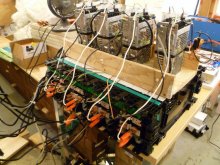Blocking diodes.
1. Meanwell and other power sources, boost converters - good practice to use a blocking diode to prevent current back flow.
2. Solar panels have the same to prevent batteries from being drained when the sun don't shine
This thread is to collect the Off the Shelf products out there we can use and post your solution for blocking diodes.
Previous Threads:

 diysolarforum.com
diysolarforum.com

 diysolarforum.com
diysolarforum.com
Possible Solutions:
Question:
1. Will this item work ? DIODE MODULE 600V 60A SOT227B , this a Fast Recovery Epitaxial Diode (FRED), sounds fancy, but comes in a mountable solution.
 www.digikey.com
www.digikey.com
2. Aliexpress has 15A and 50A blocking diodes already mounted on panels,

 www.aliexpress.com
www.aliexpress.com
curious why they skipped the heat sink on these.
1. Meanwell and other power sources, boost converters - good practice to use a blocking diode to prevent current back flow.
2. Solar panels have the same to prevent batteries from being drained when the sun don't shine
This thread is to collect the Off the Shelf products out there we can use and post your solution for blocking diodes.
Previous Threads:

MC4 diode
Can anyone recommend a high quality MC4 type blocking diode? I need a 10 amp.

Bypass/Blocking Diode Alternative
For those of you using Blocking Diodes you know that there is a constant power loss from them. Unlike Bypass Diodes, Blocking Diodes are under most circumstance forward biased, which means they introduce a .4 volt drop in each circuit. If you are pumping a lot of amps through your panels then...
Possible Solutions:
Question:
1. Will this item work ? DIODE MODULE 600V 60A SOT227B , this a Fast Recovery Epitaxial Diode (FRED), sounds fancy, but comes in a mountable solution.
DSEI2X61-06C IXYS | Discrete Semiconductor Products | DigiKey
Order today, ships today. DSEI2X61-06C – Diode Array 2 Independent Standard 600 V 60A Chassis Mount SOT-227-4, miniBLOC from IXYS. Pricing and Availability on millions of electronic components from Digi-Key Electronics.
2. Aliexpress has 15A and 50A blocking diodes already mounted on panels,

8.67US $ 23% OFF|50a 12v 24v 36v High Voltage Ideal Diode Controller Solar Battery Charging Anti-backflow Protection Board Dc 9v-45v - Solar Controllers - AliExpress
Smarter Shopping, Better Living! Aliexpress.com
curious why they skipped the heat sink on these.



